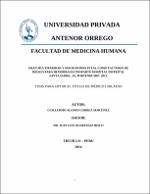Mostrar el registro sencillo del ítem
Gran multiparidad y macrosomía fetal como factores de riesgo para hemorragia posparto hospital Distrital Santa Isabel el Porvenir 2007- 2013
| dc.contributor.advisor | Olórtegui Risco, Juan Luis | |
| dc.contributor.author | Correa Martinez, Guillermo Alonso | |
| dc.creator | Correa Martinez, Guillermo Alonso | |
| dc.date.accessioned | 2014-11-25T22:00:29Z | |
| dc.date.available | 2014-11-25T22:00:29Z | |
| dc.date.issued | 2014 | |
| dc.identifier.uri | https://hdl.handle.net/20.500.12759/520 | |
| dc.description.abstract | Evaluar la gran multiparidad y la macrosomía fetal como factores de riesgo para el desarrollo de la hemorragia posparto, en pacientes atendidas en el Hospital Distrital Santa Isabel de El Porvenir durante el período del 2007 al 2013. MATERIAL Y MÉTODO: Se realizó un estudio observacional, analítico, de caso y controles, que evaluó 445 mujeres, 89 con hemorragia postparto (casos), 356 mujeres sin hemorragia postparto. RESULTADOS: El 16.9% de las mujeres que presentaron hemorragia postparto tuvieron la característica de grandes multíparas, mientras que el 9.4% de las mujeres que no tuvieron hemorragia postparto fueron grandes multíparas. La gran multiparidad es factor de riesgo de hemorragia postparto, con un OR= 1.97 con un IC al 95% 1.02 y 3.82 (p=0.04). La macrosomía fetal es factor de riesgo de hemorragia postparto, hallándose un OR= 3.01 con un IC al 95% que fluctúa entre 1.42 y 6.77 (p=0.001). CONCLUSIONES: La frecuencia de gran multiparidad en mujeres con hemorragia postparto fue 16.9% y en las mujeres sin hemorragia postparto fue 9.3%. La frecuencia de macrosomía fetal en mujeres con hemorragia postparto fue 12.4% y en las mujeres sin hemorragia postparto fue 4.7%. La gran multiparidad y macrosomía fetal son factores de riesgo de hemorragia postparto. | es_PE |
| dc.description.abstract | Evaluate the Grand multiparity and fetal macrosomia are risk factors for the development of hemorrhage postpartum patients treated at the District Hospital of Santa Isabel, El Porvenir during the period from 2007 to 2013. MATERIAL AND METHODS: An observational, analytical, retrospective cohort study, which evaluated 393 pregnant women divided into two groups, 89 hemorrhage postpartum, 89 not hemorrhage postpartum RESULTS: Women whom had PPH the 16.9% had the characteristic of large multiparous, while women whom did not have PPH 9.3% were large multiparous, the Grand multiparity is risk factor for postpartum hemorrhage, with an OR = 1.97 with 95% CI 1.02 and 3.82 (p = 0.04). Fetal macrosomia is risk factor for postpartum hemorrhage, finding an OR = 3.01 with CI 95% between 1.42 and 6.77 (p = 0.001) CONCLUSIONS: The frequency of Grand multiparity in women with postpartum hemorrhage was 16.9% and in women without hemorrhage postpartum was 9.3%. The frequency of fetal macrosomia in women with postpartum hemorrhage was 12.4% and in women without hemorrhage postpartum was 4.7%. The Grand multiparity and fetal macrosomia are risk factors of postpartum hemorrhage | en_US |
| dc.description.uri | Tesis | es_PE |
| dc.format | application/pdf | es_PE |
| dc.language.iso | spa | es_PE |
| dc.publisher | Universidad Privada Antenor Orrego | es_PE |
| dc.rights | info:eu-repo/semantics/openAccess | es_PE |
| dc.rights.uri | https://creativecommons.org/licenses/by/4.0/ | es_PE |
| dc.source | Universidad Privada Antenor Orrego | es_PE |
| dc.source | Repositorio Institucional - UPAO | es_PE |
| dc.subject | Hemorragia posparto | es_PE |
| dc.subject | Macrosomía fetal | es_PE |
| dc.title | Gran multiparidad y macrosomía fetal como factores de riesgo para hemorragia posparto hospital Distrital Santa Isabel el Porvenir 2007- 2013 | es_PE |
| dc.type | info:eu-repo/semantics/bachelorThesis | es_PE |
| thesis.degree.level | Título Profesional | es_PE |
| thesis.degree.grantor | Universidad Privada Antenor Orrego. Facultad de Medicina Humana | es_PE |
| thesis.degree.name | Médico Cirujano | es_PE |
| thesis.degree.discipline | Medicina Humana | es_PE |
| dc.subject.ocde | https://purl.org/pe-repo/ocde/ford#3.02.27 | es_PE |
| renati.type | https://purl.org/pe-repo/renati/type#tesis | es_PE |
| renati.level | https://purl.org/pe-repo/renati/level#tituloProfesional | es_PE |
| renati.discipline | 912016 | es_PE |
| dc.publisher.country | PE | es_PE |
Ficheros en el ítem
Este ítem aparece en la(s) siguiente(s) colección(es)
-
Medicina Humana [2969]


